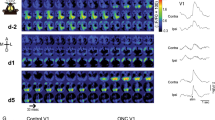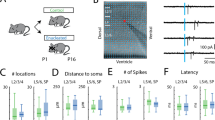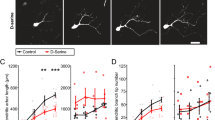Abstract
Cytochrome oxidase (cytochrome c oxidase; ferrocytochrome c: oxygen oxidoreductase, EC 1.9.2.1) has been introduced as an oxidative metabolic marker for neurones in the central nervous system1. Previous studies have shown that mature neurones remained sensitive to altered functional demands2–9, and that both developing and adult neurones responded to sensory deprivation or deafferentation by reducing their cytochrome oxidase (Cyt.Ox.) activity1,3,4,9–11. More recently, we showed that the blockage of retinal impulse transmission with tetrodotoxin led to a reversible reduction in Cyt.Ox. staining of affected lateral geniculate (LGN) and striate neurones in adult cats9. The present study sought to extend these findings to adult monkeys, where Cyt.Ox. ‘puffs’ or ‘blobs’ are uniquely present in the visual cortex10,12–14. We found that, while the retina remained histologically intact, with only moderate decreases in Cyt.Ox. staining of large ganglion cells and the two plexiform layers, subtle changes occurred in the LGN as early as 1 day post-tetrodotoxin injection, and clear reduction in enzyme levels was evident in both the LGN and the visual cortex by 3 days. Changes became progressively more severe up to 4 weeks post-injection. Within area 17, alternating bands of high and low Cyt.Ox. staining occurred in lamina IV, with alternating rows of dark and lightly reactive puffs superimposed in exact register. Thus, the mature visual neurones in the primate remain extremely sensitive to the cessation of retinal impulse transmission, and plastic metabolic changes occur through several synapses along the sensory pathway.
This is a preview of subscription content, access via your institution
Access options
Subscribe to this journal
Receive 51 print issues and online access
$199.00 per year
only $3.90 per issue
Buy this article
- Purchase on Springer Link
- Instant access to full article PDF
Prices may be subject to local taxes which are calculated during checkout
Similar content being viewed by others
References
Wong-Riley, M. T. T. Brain Res. 171, 11–28 (1979).
Merrill, E. G. & Wall, P. D. in Neuronal Plasticity (ed. Cotman, C. W.) 97–111 (Raven, New York, 1978).
Wong-Riley, M. T. T., Merzenich, M. M. & Leake, P. A. Brain Res. 141, 185–192 (1978).
Wong-Riley, M. T. T. & Welt, C. Proc. natn. Acad. Sci. U.S.A. 77, 2333–2337 (1980).
Frank, J. I. Brain Res. 186, 458–462 (1980).
Merzenich, M. M. et al. Soc. Neurosci. Abstr. 6, 651 (1980).
Robbins, N. Trends Neurosci. 3, 120–122 (1980).
Dietrich, W. D., Durham, D., Lowry, O. H. & Woolsey, T. A. J. Neurosci. 1, 929–935 (1981).
Wong-Riley, M. & Riley, D. A. Brain Res. 261, 185–193 (1983).
Horton, J. C. & Hubel, D. H. Nature 292, 762–764 (1981).
Graybiel, A. M. & Ragsdale, C. W. Jr Nature 299, 439–442 (1982).
Humphrey, A. L. & Hendrickson, A. E. Soc. Neurosci. Abstr. 6, 315 (1980).
Carroll, E. & Wong-Riley, M. Soc. Neurosci. Abstr. 8, 706 (1982).
Carroll, E. W. & Wong-Riley, M. T. T. J. comp. Neurol. (in press).
Kageyama, G. H. & Wong-Riley, M. Soc. Neurosci. Abstr. 9, 814 (1983).
Kageyama, G. H. & Wong-Riley, M. J. Neurosci. (submitted).
Polyak, S. in The Vertebrate Visual System (ed. Kluver, H.) 354–445 (University of Chicago Press, 1957).
Horton, J. C. & Hubel, D. H. Soc. Neurosci. Abstr. 6, 315 (1980).
Tootell, R. B. H. & Silverman, M. S. Soc. Neurosci. Abstr. 7, 356 (1981).
Hendrickson, A. E., Hunt, S. P. & Wu, J. Y. Nature 292, 605–607 (1981).
Archer, S. M., Dubin, M. W. & Stark, L. A. Science 217, 743–745 (1982).
Stryker, M. P. Soc. Neurosci. Abstr. 7, 842 (1981).
Glees, P. & Le Gros Cbark, W. E. J. Anat. 75, 295–308 (1941).
Matthews, M. R., Cowan, W. M. & Powell, T. P. S. J. Anat. 94, 145–169 (1960).
Hubel, D. H., Wiesel, T. N. & LeVay, S. Cold Spring Harb. Symp. quant. Biol. 40, 581–589 (1976).
Hubel, D. H. & Wiesel, T. N. J. comp. Neurol. 146, 421–450 (1972).
Lund, J. S. J. comp. Neurol. 164, 287–304 (1973).
Hendrickson, A. E., Wilson, J. R. & Ogren, M. P. J. comp. Neurol. 182, 123–136 (1978).
Weber, J. T., Huerta, M. F., Kaas, J. H. & Harting, J. K. J. comp. Neurol. 213, 135–145 (1983).
Fitzpatrick, D., Itoh, K. & Diamond, I. T. J. Neurosci. 3, 673–702 (1983).
Author information
Authors and Affiliations
Rights and permissions
About this article
Cite this article
Wong-Riley, M., Carroll, E. Effect of impulse blockage on cytochrome oxidase activity in monkey visual system. Nature 307, 262–264 (1984). https://doi.org/10.1038/307262a0
Received:
Accepted:
Issue Date:
DOI: https://doi.org/10.1038/307262a0
This article is cited by
-
Orientation tuning of cytochrome oxidase patches in macaque primary visual cortex
Nature Neuroscience (2011)
-
Changes in the neuronal activity in the pedunculopontine nucleus in chronic MPTP-treated primates: an in situ hybridization study of cytochrome oxidase subunit I, choline acetyl transferase and substance P mRNA expression
Journal of Neural Transmission (2007)
-
Gene expression of receptors and enzymes involved in GABAergic and glutamatergic neurotransmission in the CNS of rats behaviourally dependent on ethanol
British Journal of Pharmacology (2000)
-
Effect of retinal impulse blockage on cytochrome oxidase-poor interpuffs in the macaque striate cortex: quantitative EM analysis of neurons
Journal of Neurocytology (1994)
Comments
By submitting a comment you agree to abide by our Terms and Community Guidelines. If you find something abusive or that does not comply with our terms or guidelines please flag it as inappropriate.



